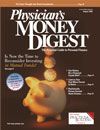Put Extra Thought into Bond Investments
The
dilemma:
The Federal Reserve has beenraising short-term interest ratessince June 2004. As a result,many physician-investors havetheir bond money in money market accounts,waiting to invest when interestrates peak. If you're one of these patientinvestors, consider stopping by www.costofwaiting.com. There's a great calculatoron the site that compares the yield you canlock in by investing today with what youmight earn if you choose to wait. Sure yields might go up, but willit be enough to compensate for waiting?
You'll need three pieces of informationto use the calculator: your investment timeline, the yield on a security that matures atthe end of your investment time line, andthe current money market yield. The calculatorwill then compute a matrix ofannual returns. The calculator also computesrequired breakeven yields based on aspecific waiting period. For example, thecurrent 5-year US Treasury note yields4.2%. With money market rates at about2% right now, the following list providesrequired breakeven yields:
- If you wait 6 months, you mustinvest in a bond that matures in 4 yearsand yields better than 4.45%.
- If you wait 12 months, you mustinvest in a bond that matures in 4 yearsand yields better than 4.75%.
- If you wait 24 months, you mustinvest in a bond that matures in 3 yearsand yields better than 5.68%.
You have to decide for yourself if interestrates are going to rise. If you're wrongand they fall, the opportunity to lock incurrent rates is lost. You could also loseout if you're correct and rates rise but nothigh enough or soon enough to offsetpotential income sacrificed by waiting.
Your biggest risk is that rates will notrise high enough and fast enough tomake waiting worth it. Although the calculatorcan lend a hand, if you're lookingfor a less tricky approach to bonds, considerusing a bond ladder strategy.
For example, let's say you have$100,000 to invest. In this case, youwould buy five different $20,000 bondsthat mature in 1 year, 2 years, 3 years,4 years, and 5 years. Then, if interestrates rise, when your 1-year bondmatures you'll use the proceeds to buy a5-year bond at the higher interest rate.If interest rates fall, however, your fourremaining bonds will continue to producea relatively attractive yield.
is the founder
of the Welch Group, LLC, which
specializes in providing fee-only
wealth management services to
affluent retirees and health care professionals
throughout the United
States. He is the coauthor of J.K. Lasser's New
Rules for Estate and Tax Planning (John Wiley &
Sons, Inc; 2001). He welcomes questions or comments
at 800-709-7100 or visit www.welchgroup.com. This article was reprinted with permission
from the Birmingham Post Herald. My thanks to
Hugh Smith, CFA, for his assistance on this article.
Stewart H. Welch III
